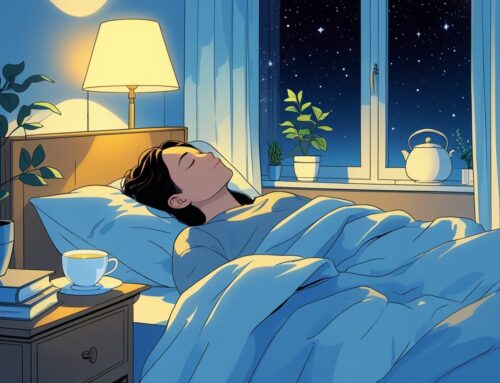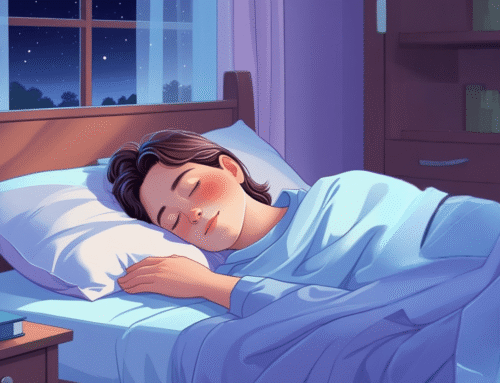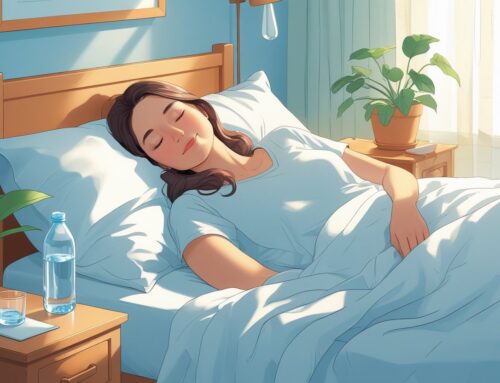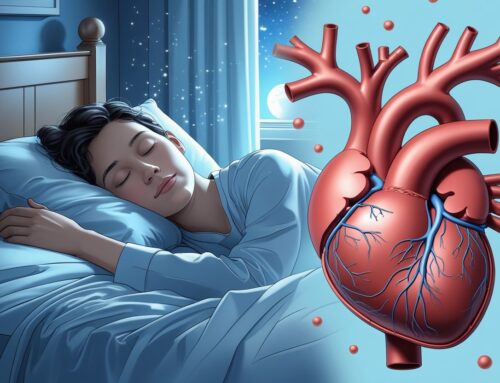Sleeping well during a period feels challenging because of cramps, hormone shifts, and discomfort. The best way to sleep on your period involves lying in the fetal position, which eases cramps and reduces pressure on your abdomen. Choosing the right position makes a significant difference in comfort and helps prevent leaks.
Pain relief and proper protection also improve sleep quality. Managing discomfort with over-the-counter pain medication and choosing reliable menstrual products allow for more restful, uninterrupted sleep. Small adjustments like these lead to a more comfortable experience throughout the night. A calming bedtime routine and a cool sleep environment help reduce restlessness.
These steps work together to support better sleep and make dealing with period symptoms at night easier for many people.
Key Takeaways
- Sleeping in the fetal position eases cramps and improves comfort.
- Pain management and menstrual protection help prevent sleep disruptions.
- Simple lifestyle changes promote more restful and uninterrupted sleep.
- A medium-firm or contouring memory foam mattress with a side-sleeping fetal position to ease period cramps, support spinal alignment, reduce lower back pain, and relieve abdominal pressure for more restful sleep.

Understanding Period Discomfort at Night

Pain and discomfort from periods make sleeping difficult. Specific changes in the body and common disruptions explain why many experience more intense cramps and restless sleep during menstruation.
Why Are Period Cramps Worse at Night?
Cramps often feel worse at night, and there are a few reasons why. During the day, your body makes more cortisol, a hormone that helps dull pain. At night, cortisol levels drop, so your brain notices the pain more.
Lying down also adds pressure in the pelvic area. Blood flow slows a bit, which makes the muscles in the uterus tighten. That tightening leads to stronger cramps. And when it’s quiet and dark, there are fewer distractions. It’s easier to focus on what you’re feeling, so the pain seems more intense. That mix of body changes and awareness is why many people notice their cramps get worse before or during sleep.
Common Sleep Disruptions During Menstruation
Periods interrupt sleep in several ways. Cramping and pain cause frequent waking. Many struggle to get comfortable because lying on the stomach increases lower back pain, while other positions feel awkward or add pressure. Other common disruptions include bloating, breast tenderness, and mood swings, which harm sleep quality. Hormonal changes during menstruation lower melatonin levels, which makes falling and staying asleep more difficult.
Stress and anxiety tied to period symptoms also worsen sleep. Poor sleep hygiene combined with discomfort results in shallow or broken sleep. Managing pain and choosing the right sleeping position help reduce these disruptions for better rest.
Best Sleeping Positions for Period Cramps
Choosing the right sleeping position helps reduce pain and improve rest during menstruation. Certain positions ease muscle tension and lower pressure on the abdomen, which makes it easier to fall asleep and stay comfortable through the night.
Fetal Position for Menstrual Relief
The fetal position is widely recommended for easing period cramps. Curling the body into a loose ball flexes the lower back and abdominal muscles gently. This reduces tension on the uterus and can lessen the feeling of cramping. For the best results, lie on your side with your knees drawn slightly toward your chest. Place a soft pillow between your legs to support the hips and keep your spine aligned. This position also prevents direct pressure on the stomach.
Many people feel comfortable in this position since it promotes deeper relaxation. It stands out as one of the best positions to lie in for cramps because it naturally limits abdominal strain and supports pain relief without added effort.
Side-Lying and Other Recommended Positions
Sleeping on the side, especially the left side, is often advised during menstruation. This position improves blood flow and lowers pressure on internal organs, which helps ease cramps. It also reduces the chance of leaking and serves as a practical choice for many.
Some find relief lying flat on their back with a pillow under the knees. This elevates the legs slightly and takes pressure off the lower back and pelvis. It works well for those who do not feel comfortable in side positions. Avoid sleeping on the stomach since it increases pressure on the abdomen and may worsen cramps. Side-lying generally offers the best balance between comfort and pain relief.
How to Adjust Your Sleeping Position
Small changes in posture make a big difference for menstrual comfort. Adding pillows strategically is key. Pillows can be placed:
- Between the knees to keep hips aligned
- Under the lower back for support
- Around the abdomen to gently cradle and ease cramps
Adjust the bed’s incline by raising the upper body or legs slightly to reduce pressure on the uterus. Wear loose clothing and apply a heating pad before bed to improve comfort. Pay close attention to your body’s signals. Shifting positions during the night and avoiding stiff postures keep blood flowing, which can reduce pain and support better rest.

How to Sleep Comfortably on Your Period
Sleeping well during a period feels challenging since cramps, night sweats, and discomfort often disrupt rest. Small changes in the bedroom and clothing choices can ease these issues and let you sleep more peacefully.
Creating a Sleep-Friendly Environment
A cool, quiet, and dark room helps lower the elevated body temperature many experience during a period. A fan or air conditioner keeps the air fresh and cool, which reduces sweating and discomfort. Earplugs or white noise machines block distracting sounds, while blackout curtains or an eye mask maintain darkness and support better sleep.
A regular bedtime routine tells the body it is time to unwind. Dimming the lights and practicing calming breathing help lessen the impact of hormones that disturb sleep.
Optimal Bedding and Sleepwear Choices
Soft and breathable sheets made of cotton or bamboo avoid irritation and lessen night sweating. Heavy blankets trap heat, so use light layers you can adjust. Loose-fitting and moisture-wicking sleepwear manages heat and eases cramp-related pain. Stretchy pajamas avoid putting pressure on the abdomen, which can soothe cramps.
Period-specific protection, such as a thin, absorbent overnight pad or menstrual cup, lowers worries about leaks. This brings comfort by allowing uninterrupted sleep.
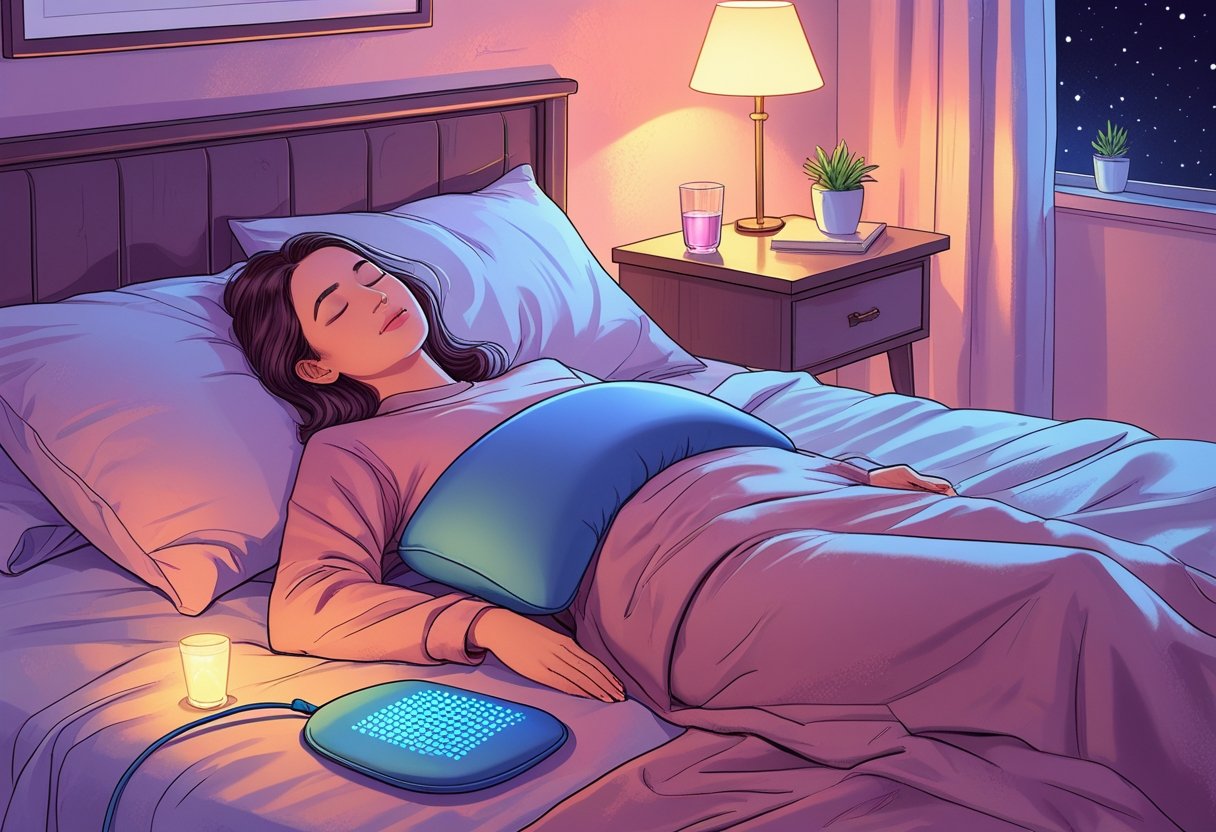
Effective Ways to Relieve Cramps for Better Sleep
Finding relief from menstrual cramps can transform how well someone sleeps. Simple steps such as adjusting body position, applying heat, and doing gentle stretches ease pain and allow rest to come more easily.
How to Get Rid of Cramps Fast in Bed
To reduce cramps quickly in bed, lie on the side and pull the knees slightly toward the chest. This fetal position relaxes lower abdominal muscles, relieving tension and pain. Placing a pillow between the knees keeps the hips aligned and reduces pressure. This adds comfort through the night and makes it easier to remain in a restful position.
Deep, slow breathing calms the body and lowers pain perception. Focusing on the breath shifts attention away from discomfort and supports relaxation, which helps with falling asleep despite cramps.
Incorporating Heat Therapy Into Your Routine
Heat effectively eases menstrual cramps. Applying a heating pad or hot water bottle to the lower abdomen or back loosens tight muscles and boosts blood flow, reducing pain. The warmth must feel soothing rather than overly hot, since extreme heat can irritate the skin. Using heat for 15 to 20 minutes before bed improves sleep quality. Some find heat patches convenient because they attach to clothing or pajamas and deliver consistent warmth overnight.
The Role of Light Stretching Before Bed
Light stretching relieves cramps by relaxing muscles and enhancing circulation in the pelvic region. Simple stretches like gentle forward bends or hip openers ready the body for rest. Stretching also reduces stiffness built up during the day or from extended sitting, which makes it easier to find a comfortable sleeping position.
Movements should remain slow and gentle to avoid worsening cramps. Stretching right before lying down relaxes the muscles and encourages better sleep.
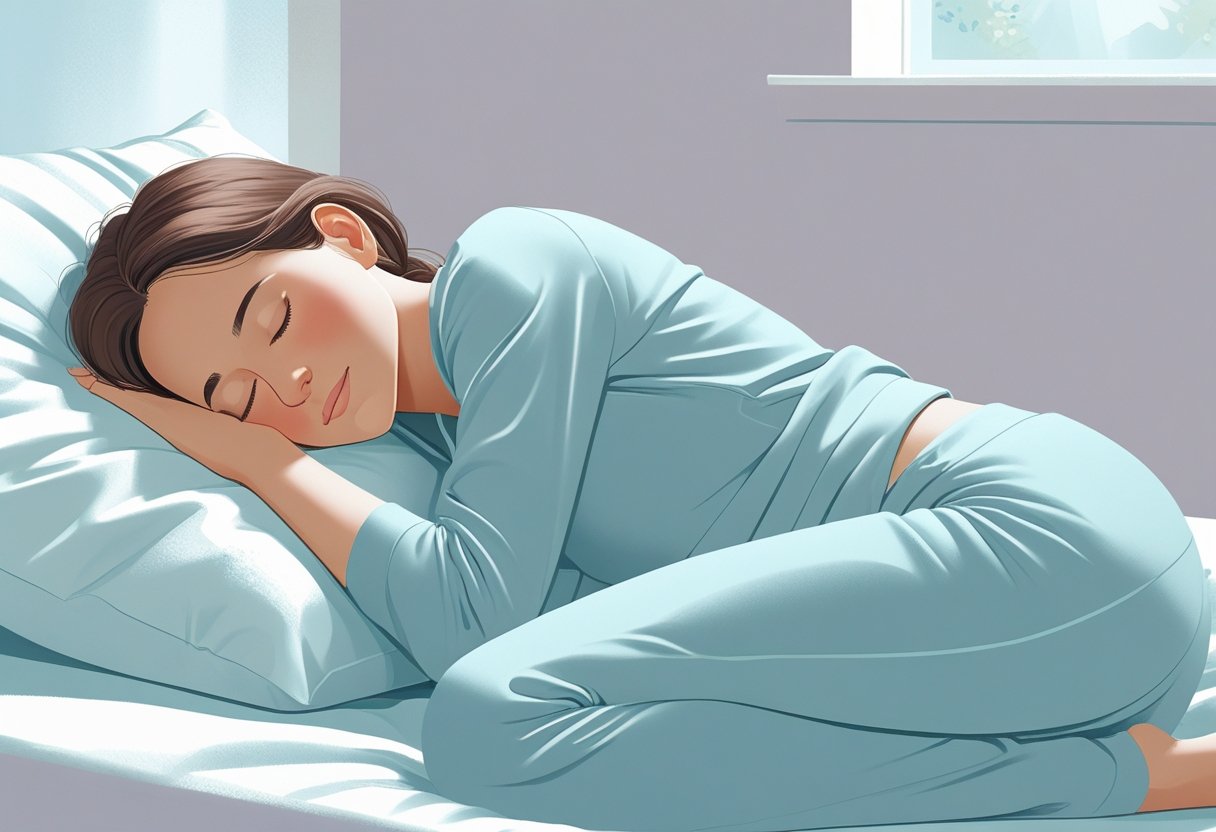
Lifestyle and Self-Care Tips for Restful Nights
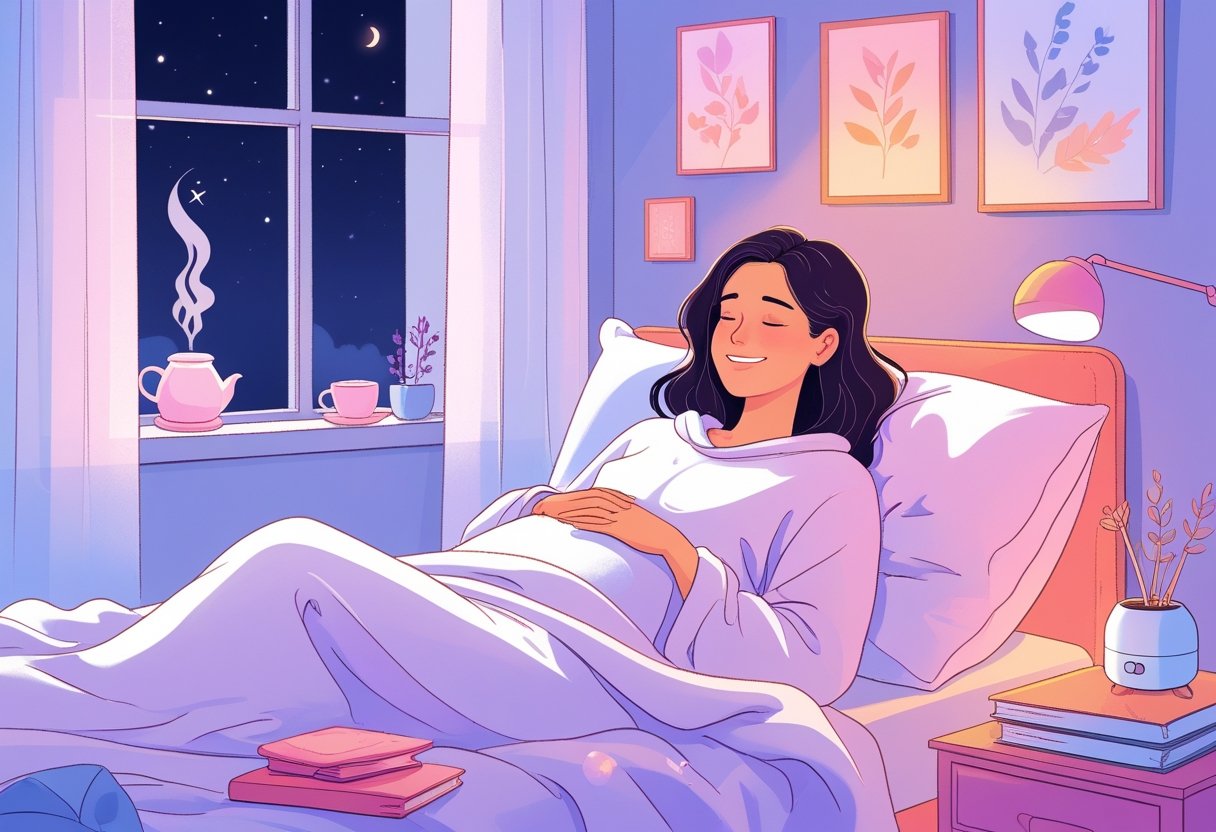
Good sleep during periods relies on small but effective changes to daily habits. Drinking the right fluids and choosing certain foods can ease cramps and discomfort. Meanwhile, simple relaxation practices calm the mind and body before bed, which improves sleep quality.
Hydration and Nutrition Recommendations
Staying hydrated reduces bloating and cramps, two common reasons for restless nights during periods. Drinking water regularly throughout the day remains essential. Avoid caffeine and alcohol near bedtime since they increase discomfort and disrupt sleep.
Foods rich in magnesium and calcium, like leafy greens, nuts, and low-fat dairy, help ease muscle cramps and encourage relaxation. Eating small, balanced meals throughout the day keeps energy stable and prevents discomfort from hunger or indigestion. Skip heavy or spicy foods before bed to lower the chance of stomach upset.
Including anti-inflammatory foods such as berries, ginger, and turmeric can reduce swelling and pain that disrupt rest. Planning meals and drinks with these foods in mind makes sleep during periods more comfortable and predictable.
Relaxation Techniques to Improve Sleep Quality
Gentle, calming activities before bed lower tension and ready the body for rest. Deep breathing exercises ease menstrual pain by boosting oxygen flow and relaxing muscles. Tensing and releasing different muscle groups, known as progressive muscle relaxation, relieves physical discomfort and restless energy. Meditation or guided imagery quiets the mind and distracts from pain.
Warm baths with Epsom salts are great since magnesium in the salts relieves cramps and soothes muscles. A heating pad or hot water bottle on the lower belly provides similar relief by improving blood flow.
Keeping a routine that includes dimming lights and limiting screen time at least an hour before bed helps the body start producing melatonin, the sleep hormone, which makes it easier to fall asleep and stay asleep during periods.
Best Mattress and Sleeping Positions for Comfort During Your Period
Choosing the right mattress helps in comfort during your period. A medium-firm mattress provides solid support while cushioning pressure points. It can help ease lower back pain, which many experience during menstruation.
Memory foam mattresses are also great. They mold to the body and relieve pressure, which may reduce cramps and improve sleep quality. For example, the Leesa Original Mattress balances contouring with support, which is great for period comfort.
The Leesa Original Mattress features a layered design that combines adaptive foam with a supportive base. This construction helps distribute weight evenly and reduces pressure points, which can prove especially beneficial during sensitive times like menstruation. Its medium-firm feel supports spinal alignment without sacrificing comfort.
Another advantage lies in the breathable cover and open-cell foam that promote airflow to keep you cool throughout the night. Since staying comfortable and cool can be harder during your period, a mattress that helps regulate temperature can make a noticeable difference in sleep quality.
Regarding sleeping positions, side sleeping is the most recommended. The fetal position, with knees slightly drawn up, helps ease cramps and lowers the risk of leaks. This posture supports the lower back and maintains proper alignment. Sleeping on the back can also feel comfortable, especially when placing a pillow under the knees to relieve lower back tension. Sleeping on the stomach is generally not advised during periods, as it can increase pressure on the abdomen and worsen cramps.
Here is a simple guide to help you choose details for comfort:
Mattress Type and Benefits
- Medium-firm: Provides good support and reduces back pain
- Memory foam: Contours to the body and relieves pressure
- Innerspring: Provides less contouring and may increase pain
Sleeping Positions and Benefits:
- Side (fetal): Eases cramps and reduces leakage
- Back: Supports the spine. Places a pillow under the knees helps relieve tension
- Stomach: Not recommended during periods
Choosing the right mattress and sleeping position can improve comfort during menstrual sleep.

Frequently Asked Questions
Finding a comfortable sleeping position and managing pain matter greatly for restful sleep during menstruation. Using reliable protection and easing cramps improve rest significantly.

